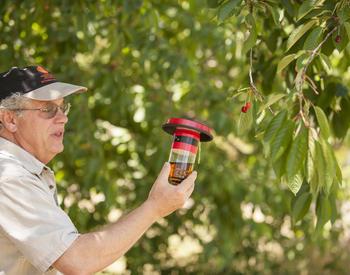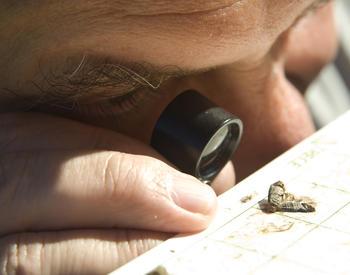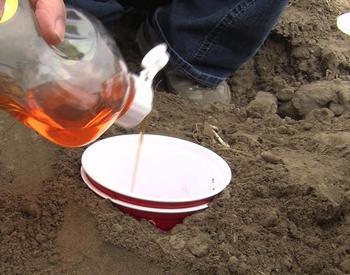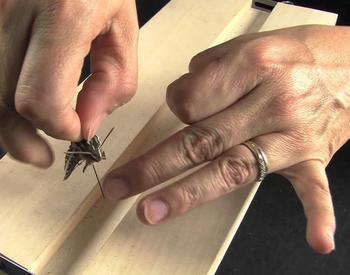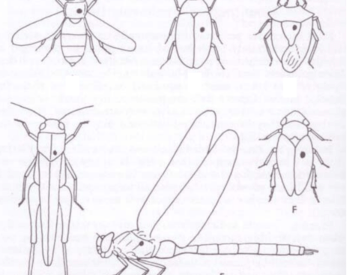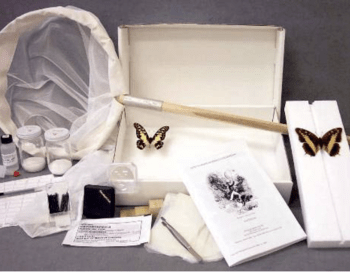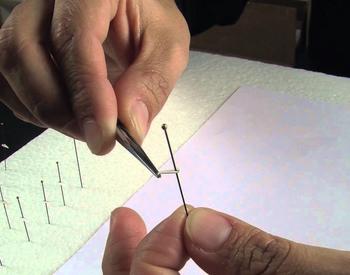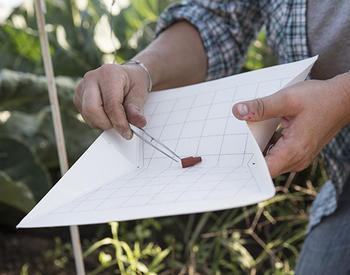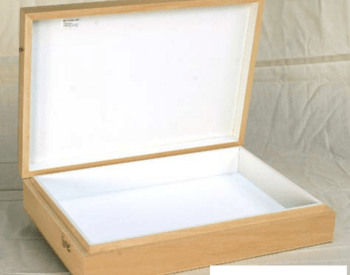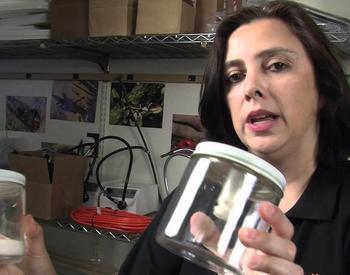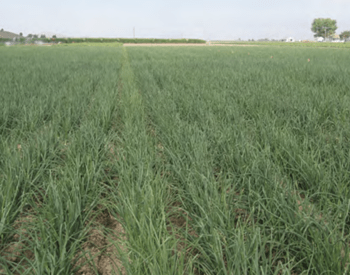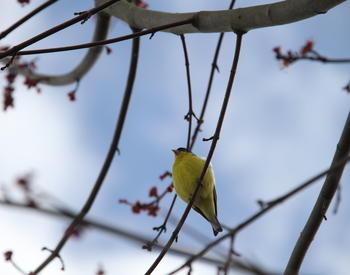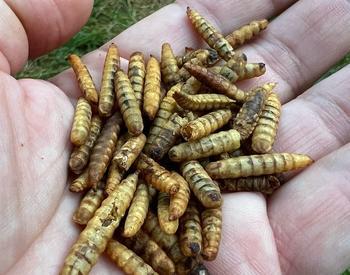Insects can be found in great numbers in every ecosystem on our planet except for the ocean. There are more than a million identified species of insects in the world, compared to just 31,000 identified species of mammals, birds, reptiles and amphibians. In the Pacific Northwest alone, more than 28,000 species of insects have been identified. In some ecosystems, there are several million insects per acre.
Insects exhibit incredible diversity and interact with almost all other living species in one way or another. You can't study any part of nature without seeing a direct or indirect connection to insects.
Insects and humans
Of the more than 100,000 insect species found in North America, very few are harmful to humans.
A “bad insect” is an insect that is doing something we don't want: chewing holes in our flowers, eating our fruits or annoying us in general. In another location or at another time, we might consider the same insect "good."
Most insects found in our gardens and yards are "benign" or "beneficial." The beneficial ones pollinate plants or eat other insects that are trying to eat our plants.
The value of insects:
- Pollinate many food crops.
- Parasitize or eat many troublesome insects and weeds.
- Improve soil fertility by being master recyclers and decomposers.
- Provide silk, dyes, pigments, shellac, honey, beeswax, fish bait and galls (tannic acid and inks).
- Are a source of food for other animals and humans.
- Contribute to scientific advances in genetics and medicine.
- Provide aesthetic and entertainment value.
Growth of insects
Most insects (more than 90 percent) undergo a change in shape during their life. This change is called metamorphosis. There are three types of metamorphosis. Some insects, such as silverfish, do not go through true metamorphosis. When it hatches from the egg, these insects look just like the adults, except in size.
In gradual or simple metamorphosis, there are three life stages: egg, nymph and adult. All of the life stages look similar, and they often behave similarly. All life stages can be found together. In the final development stage (the adult), wing pads develop into wings.
In complete metamorphosis, the insect has four life stages: egg, larvae, pupa and adult.
Common Oregon insect groups
Insect classification systems are constantly changing. As a result, several different classification systems are currently used by entomologists. The system presented in this article has been widely used for many years and is the basis of most reference books. This makes it easy to find identification help.
Grasshoppers and crickets: Orthoptera (straight wings)
Notes and general characteristics
- 25,700+ known species.
- Orthoptera are the largest group of insects that undergo simple/gradual metamorphosis: egg, nymph and adult.
- Immature stages (nymphs) resemble adults but are wingless.
- Hearing is acutely developed in most Orthoptera. Auditory stimuli are important for courtship in many species.
Identification
- Hind legs are enlarged for jumping. Nearly all Orthoptera are readily distinguished from other insect orders by the enlarged hind femora and the characteristic grasshopper-like shape.
- Forewings are elongated, narrow and leathery or parchment-like with branched veins. Hind wings have numerous straight, longitudinal veins, with numerous cross veins forming many closed cells. Wings are folded by pleats.
- Compound eyes are present. Acute vision occurs in some species.
- Chewing mouthparts. The great majority of these species are herbivores with specialized dentition for consuming "tough" plant matter. Both adults and nymphs are damaging.
- Antennae are multiarticulate (many jointed), filiform (thread-like) or moniliform (beaded like a necklace).
Cockroaches: Blattodea
Notes and general characteristics
- One of the most familiar insects to a nonentomologist.
- This order has an old fossil record. There are 3,500+ known species.
- About 30 species are cosmopolitan (worldwide) coinhabitators with humans.
- The mode of oviposition (egg laying) is unique; an egg case is produced.
- These insects are usually nocturnal (they come out at night). They are positive thigmotactic, meaning that they are contact-loving. This term is applied to species that tend to live close together or in touch with one another.
- Some adults can live up to four years. Most species are very hardy.
- Cockroaches do not bite, sting or spread human diseases. However, they can carry pathogenic organisms.
- Undergoes simple/gradual metamorphosis: egg, nymph and adult.
Identification
- Large compound eyes.
- Chewing mouthparts.
- Antennae are long, filiform (thread-like) and multiarticulate (many-jointed).
- Forewings are hard and leathery relative to hind wings. Hind wings are membranous with a large fan-shaped anal lobe. Many pleats in the wing aid in folding.
- The hind femur is not enlarged, but legs are robust, usually long and often spiny. Tarsi have five segments.
Mantids: Mantodea
Notes and general characteristics
- 3,500+ known species.
- Undergoes simple/gradual metamorphosis: egg, nymph and adult.
- The classic praying mantis pose is an ambush pose. They will eat anything they can ambush and subdue.
- Like cockroaches, mantids lay their eggs in an egg case. The arrangement and form of the egg case is unique to this suborder of insects.
Identification
- The body is long with a small head that is freely mobile on a slender neck.
- Large compound eyes are situated far apart (as in other visually orienting predators such as dragonflies).
- Chewing mouthparts.
- Antennae are slender, filiform (thread-like) and multiarticulate (many-jointed).
- Forewings are narrow and usually thickened and leathery. Hind wings are much broader and membranous with many pleats.
Walking sticks: Phasmatodea
Notes and general characteristics
- 2,000+ known species.
- Undergoes simple/gradual metamorphosis: egg, nymph and adult.
- All are herbivores.
- Generally rare, even given their ability to hide in plain sight. These species seldom are economically important.
- This order includes the largest known living insect.
Identification
- Body shape is cylindrical, elongated and flattened.
- Antennae are filiform (thread-like) or moniliform (beaded like a necklace).
- Compound eyes are present.
- Chewing mouthparts.
- Forewings are narrow and usually thickened and leathery. Hind wings are much broader and membranous with many pleats.
- Legs usually are elongated and slender.
Termites: Isoptera (equal wings)
Notes and general characteristics
- 2,000+ known species.
- Termites seldom venture out of their concealed nest, with the exception of the reproductive forms, which disperse (swarm) by air to found new colonies.
- Because of the damage termites can cause, especially in subtropical and tropical regions, they are one of the most destructive arthropods. They are found in all but extremely cold regions.
- Like some Hymenoptera families, termites are of special biological interest because of their highly developed social behavior and colonies.
- Undergoes simple/gradual metamorphosis: egg, nymph and adult.
Identification
- Front and hind wings are similar in size and shape, hence the order name. Wings have numerous longitudinal veins, with many crossing veins creating many closed cells. Wings are present only on reproductive forms, and the wings are twice the length of the body.
- The abdomen is broadly joined to the thorax.
- Compound eyes.
- Chewing mouthparts.
- Antennae are moniliform (bead-like) with 10–32 segments.
- Differentiating termites and ants:
- Wings: Termite reproductives have two large wings on each side, similar in size and shape and longer than the body. Ants also have two wings on each side, but the hind wing is much smaller than the forewing.
- Antennae: Termite antennae look like a string of beads (moniliform). Ants' antennae are elbowed, and a distinct bend is visible in the antennae.
- Eyes: Termites have reduced eyes. Ants usually have large compound eyes.
- Waist (how the thorax and abdomen are connected): Termites have no waist; the thorax and abdomen are broadly connected, resembling a solid tube that is rounded at the end. Ants have a narrow connection between the thorax and abdomen, which is slightly pointed at the end.
Earwigs: Dermaptera (leather wings)
Notes and general characteristics
- 1,200+ known species.
- Often confused with some rove beetles (Staphylinidae), which have no forceps.
- Undergoes simple/gradual metamorphosis: egg, nymph and adult. Adults and nymphs are similar in appearance.
- Most are omnivorous, but some are predatory.
- Most are nocturnal (active at night).
- The highly developed maternal care of their young makes this order different and notable. The females often protect their eggs and young nymphs for several weeks.
Identification
- The forcipulae (forceps) cerci (the pinchers/forceps) on the end of the abdomen distinguish earwigs from all other insects except some uncommon Diplura species.
- Antennae are multiarticulate and filiform (thread-like).
- Chewing mouth parts.
- When present, front wings are short and elytriform (thickened/leathery). Hind wings are ear shaped and semicircular with a distinctive radiating venation.
- The body is elongated and slightly flattened with a leathery cuticle.
- Compound eyes are moderate or absent. Termite antennae look like a string of beads (moniliform).
True bugs, plant hoppers: Hemiptera (different wings)
Notes and general characteristics
- Undergoes simple/gradual metamorphosis: egg, nymph and adult.
- 80,000+ known species in this suborder.
- Adults and nymphs usually resemble each other. Both stages can be damaging.
- The bug name is written as two words: stink bug, assassin bug, bed bug.
- Most Hemiptera have scent glands on the thorax, which give off a characteristic odor and are unpleasant to most people.
- Many feed on plants and are serious pests of cultivated plants. Some are predaceous and very beneficial to people. Still others suck human and other animal blood or act as disease vectors.
Identification
- One of the most distinctive features of the Hemiptera, and the one from which the order gets its name, is the structure of the front wings: hemi = half, ptera = wings. In most Hemiptera, the front portion of the front wing is thickened and leathery or parchment-like, and the hind portion (wing tip) of the wing is membranous. In other words, there are different textures on the same wing. The hind wings are entirely membranous and are slightly shorter than the front wings. There are two pairs of wings (four wings total).
- Hemiptera wings fold flat over the abdomen, usually without folds. Rather, they cross over each other and form a triangular shield on the back. Forewings are larger then hind wings.
- Hemiptera mouthparts are piercing-sucking and form a needle-like beak, which extends from the front part of the head. (In Homoptera, the mouthparts arise at the rear of the head.)
- Compound eyes are well developed.
- Antennae usually have ten or fewer segments, most commonly four or five. Segments can be short, but are usually long and filiform or setaceous.
Aphids, scales, mealybugs, whiteflies, cicadas: Homoptera (same wings)
Notes and general characteristics
- 32,000+ species.
- Most are small, soft-bodied insects. Cicadas are an exception.
- Body forms vary considerably, and some species have very complex life histories.
- All Homoptera are plant (phloem) feeders, and many are serious pests of cultivated plants.
- Some species transmit plant diseases.
- Homoptera are major honeydew producers.
- Eggs usually have a simple, ovoid structure.
- A few Homoptera are beneficial and serve as a source of shellac, dyes or other materials.
Identification
- The Homoptera sucking mouthpart is formed into a needle-like beak that extends from the back part of the head. (In Hemiptera, the mouthparts arise at the front of the head.)
- There are winged and unwinged forms. When wings are present, they are either uniformly membranous or uniformly leathery or parchment-like. The name Homoptera means uniform wing.
- Aphids have cornicles on the end of their abdomen.
Heteropterans you might encounter as a gardener
- Stink bugs.
- Harlequin bugs.
- Squash bugs.
- Milkweed bugs.
- Assassin bugs.
- Plant bugs.
- Bed bugs.
- Mealybugs.
- Whiteflies.
- Scales.
- Aphids.
Thrips: Thysanoptera (fringe wings)
Notes and general characteristics
- 2,000+ known species.
- Thrips are highly distinctive insects that inhabit all sorts of vegetation, as well as leaf litter, fungus and decaying parts of trees.
- Many thrips are plant feeders. They preferentially infest the reproductive structures of plants, and the most serious economic damage involves buds, flowers and young fruits.
- Some are vectors of bacterial, fungal or viral diseases of plants.
- Some are predators of aphids or other small, soft-bodied arthropods, especially eggs of mites and Lepidoptera.
- Thrips occasionally cause problems or become a nuisance by biting humans.
- Undergoes simple/gradual metamorphosis: egg, nymph and adult.
- Winged thrips are competent fliers and may be disseminated long distances by favorable winds.
Identification
- Small—usually less than 1.5 mm (1⁄16 inch).
- The four wings are narrow, straplike and fringed with long setae. The fringe of hairs is often as long as the wing is wide. This is a specialization that appears often in very small insects.
- Eyes are prominent, round or kidney-shaped with large, round facets.
- Mouthparts are modified as piercing stylets. This method of feeding produces a characteristic mottling or silvering of the affected plant surfaces.
- Antennae are four- to nine-segmented.
Lacewings, ant lions, snakeflies: Neuroptera (nerve or net wings)
Notes and general characteristics
- 5,000+ known species.
- Wings usually are longer than the abdomen. Almost all Neuropterans are weak, erratic fliers.
- Undergoes complete metamorphosis: egg, larva (grubs), pupa and adult.
- Adult Neuropterans are predominantly predators and help in regulating damaging invertebrate populations on plants. Immature Neuropterans are all predatory.
- The famous ant lion belongs to this order. Ant lions have a broad head with enormous, sickle-shaped jaws. They lie in ambush at the bottom of a conical pitfall into which ants and other insects fall.
Identification
- Usually have large, lateral eyes.
- Biting/chewing mouthparts.
- Antennae are multiarticulate, usually filiform or moniliform.
- There are two pairs of membranous wings with numerous branched, longitudinal veins and many closed cells.
- Most species are elongate-oval in shape and similar in size.
Neuropterans you might encounter as a gardener
- Ant lions: Adult ant lions look much like damselflies with their long, slender abdomen and long, narrow, many-veined wings.
- Snakeflies.
- Lacewings: green and brown.
Beetles: Coleoptera (sheath wings)
Notes and general characteristics
- This is the largest insect order (300,000+ species).
- Undergoes complete metamorphosis: egg, larva (grubs), pupa and adult.
- Due to the large number of beetles, they are exceedingly variable in form and biology and in the ecological habitat where they are found.
- Beetles are hard (armored) and compact in form. They look like the tanks of the insect world.
- Generally, beetles are relatively inefficient fliers.
- Beetles may be found in almost every type of habitat in which insects are found. Many are plant feeders, but some are important predators of other invertebrates.
- Antennae and legs often fit into groves or depressions on the body as further protection.
- Beetles are one of the more common insects in arid habitats.
- Weevils (Curculionidae): There are more than 60,000 weevil species worldwide. Their jaws are at the end of their nose.
Identification
- One of the most distinctive characteristics of Coleoptera species is the structure of the wings. When wings are present, there are always two pairs (four wings total). The front wings are thickened, hard, brittle or leathery. They usually meet in a straight line down the middle of the beetle’s back and cover the hind wings. This is what gives the order its name. Elytra are the name given to these special front wings. The hind wings of beetles fold under the elytra through a complex series of folds that allow the relativity large hind wing to fit under the elytra.
- Antennae almost always have 11 or fewer segments.
- Well-developed chewing month parts. One species is known for chewing through the lead sheathing of telephone cables.
- Larvae have a head capsule, three pairs of legs on the thorax and no legs on the abdomen. Weevils do not have any legs in the larval stage.
Beetles you might encounter as a gardener
- Less than 6 mm (¼”) in length:
- Flea beetles.
- Drug store beetles.
- Dermestid beetles.
- Small ground beetles.
- General storage pest beetles.
- Fruit/sap beetles.
- Bark beetles.
- 6-20 mm (¼–¾”) in length
- Ladybird beetles.
- Black ground beetles.
- Tule beetles.
- Click beetles.
- Brown leatherwing.
- California glowworm.
- Western spotted cucumber beetle.
- Strawberry root weevil.
- 20 mm (¾”) or longer
- Nautical borer.
- Ten-lined June beetles.
- Pine sawyer.
- California prionus.
- Banded alder borer.
Flies, mosquitoes, gnats: Diptera (two wings)
Notes and general characteristics
- The names of true flies are written as two words: house fly, bot fly. For all other "flies," the name is combined: butterfly, dragonfly, caddisfly.
- 120,000+ species.
- Undergoes complete metamorphosis: egg, larva (grubs), pupa and adult.
- Dipterans are considered one of the dominant insect groups because of their extreme abundance in a great variety of ecological situations.
- Most are liquid feeders and live on or in dead/decaying animal or vegetable matter; however, some are important predators, parasites or parasitoids.
- Almost no adult Diptera directly damage living plants except by oviposition.
- Most larvae occur predominantly in moist or subaquatic situations, and they are noted for fast development.
- For Dipterans, the larval stage is usually the feeding stage, and the adult is the short-lived reproductive and dispersal stage.
- Diptera larvae are the only significant groups of insects that are internal parasites of vertebrates.
- The major impact of Diptera (mosquitoes) on humans stems from their transmission of diseases of humans and domestic animals. The diseases vectored by mosquitoes (including malaria, yellow fever and encephalitis) have changed the course of history several times.
- Dipterans' wings have evolved with a high degree of adaptation for rapid, efficient flight.
Identification
- The most unique characteristic that distinguishes Dipterans from all other insect orders is their single pair of wings (two wings total). The front wings are membranous. Behind the front wings, where the second pair of wings is in other insects, are halters. Halters look like a club and help the "fly" maintain its balance while flying.
- Wings have few or numerous longitudinal veins and few closed cells.
- Usually have large, compound eyes.
- Mouthparts are modified, usually as a proboscis for imbibing liquid foods. They do this by rasping, cutting, sucking, sponging and piercing.
- Antennae are multiarticulate, filiform, moniliform or reduced, with the terminal segment bristle shaped.
- Larvae usually are maggot-like or vermiform (having the shape of a worm). Larvae have no true legs.
- On some species, antennae have six or more segments and are feathery. These are known as long-horned flies: crane flies, midges, gnats, mosquitoes, black flies. Species with fewer than six segments in very short antennae are known as short-horned flies: horse flies, house flies, flower flies, fruit flies.
Moths and butterflies: Lepidoptera (scale wings)
Notes and general characteristics
- 130,000+ known species.
- Undergoes complete metamorphosis: egg, larva (worms-caterpillars-inchworms), pupa (cocoons-chrysalis) and adult.
- Most larvae feed on flowering plants and conifers (gymnosperms) and can cause great damage to plants.
- Silk production is universal among Lepidoptera larvae.
- Egg forms are extremely variable (cylindrical, barrel-shaped or flat wafers).
- Flight is powered by both wings.
Identification
- Mouthparts are a modified coiled proboscis. With few exceptions, adults feed on nectar, honeydew, fermenting sap or similar products.
- Adults are soft bodied.
- There are two pairs of membranous wings (four wings total). Wings are scaly or powdery and often showy in color. Handle these insects with care, as the scales can easily rub off, causing difficulty in flying.
- The hind wing is coupled to the forewing through several different ways of overlapping the wings.
- Larvae have chewing mouthparts and are caterpillars or worm-like. True legs are on the thorax, and prolegs are found on the abdomen. Prolegs are not true legs and can vary in color. Due to their feeding habits, larvae can be very damaging to plants.
- Antennae take various forms. Moths have antennae that are not knobbed/clubbed at the tip. These species usually fly by night and are hairy with bushy antennae. In butterflies and skippers, the antennae are thread-like and swollen, knobbed or clubbed at the tip. These species usually fly during the day and have delicate antennae.
- Butterflies have clubbed antennae that are not hooked at the tip. Skippers have clubbed antennae with hooked tips.
- To key beyond this simple separation of the superfamilies of the Lepidoptera, you will have to use wing venation to distinguish the different families, such as swallowtails (Papilionidae).
Sawflies, horntails, ants, wasps, bees: Hymenoptera (membrane wings)
Notes and general characteristics
- 140,000+ named species.
- Flight is powered by both wings. Hymenoptera have unique hooklike setae (bristles) that hold the forewings and hind wings together so they act as one wing. Many species are strong, efficient fliers.
- The only ants with wings are swarmers.
- Undergoes complete metamorphosis: egg, larvae, pupa and adult.
- The Hymenoptera are exceedingly important insects from a human point of view. Most are beneficial predators or parasites. Others are major pollinators for many plants.
- Ants of the species Oecophylla were first deliberately used to protect plants from pests in China 4,000 years ago. The Chinese encouraged the ants to live in fruit trees because their presence was known to improve fruit yields.
- The economic importance of Hymenopterans easily amounts to billions of dollars every year. If all of the Hymenopterans were to suddenly disappear from the earth, human society would collapse.
- Hymenoptera are known as social insects due to the colonies and complex societies some families form.
- The largest single colony of insects recorded to date is a colony of ants of the genus Formica (F. yessensis) in Japan. This super colony contains more than 300 million ants living in 45 interconnected nests.
- Parthenogenesis is more common among the Hymenoptera than any other order of animals. In many cases, it is the means of sex determination (i.e., fertilized eggs become one sex, and unfertilized eggs the other). There are some species in which males have never been found, and reproduction occurs only as a result of parthenogenesis.
Identification
- Most have chewing mouthparts. Bees have lapping mouthparts.
- Antennae are usually filiform (thread-like) or moniliform (beaded like a necklace) and shorter than the body.
- Large compound eyes.
- Most Hymenoptera have a constricted/narrow waist (petiole).
- Some sawfly larvae have three pairs of legs on the thorax and more than four pairs of legs on the abdomen. Larvae of ants, wasps and bees do not have legs.
- When wings are present, there are always two pairs (four wings total).
- Wings are membranous, clear and stiff with relatively few veins. Forewings are about 1.5 to 2 times as long as hind wings.
- An ovipositor is always present in females in one form or other. In many species, it is adapted for sawing and/or piercing and stinging.
- Tarsi can have three, but usually five, segments.
- The abdomen is broadly joined to the thorax in sawflies and horntails. The abdomen is narrowly constricted at the attachment point to thorax in ants, wasps and bees.
Hymenoptera you might encounter as a gardener
- Halictidae bee.
- Bumble bees.
- Cuckoo wasps.
- Paper wasps.
Common Oregon arachnid groups
Basic characteristics of arachnids include four pairs of legs and a body divided into two segments: the cephalothorax and the abdomen.
Spiders: Araneae
- Two body parts—the head and the cephalothorax—are joined by a narrow pedicel. Body parts are unsegmented.
- One prominent pair of pedipalps.
- Usually have six or eight simple eyes, rarely zero, two or four. Jumping spiders have the most highly developed arthropod eyes.
- There are four pairs of legs, which vary widely in color and may or may not have patterns.
- Can spin silk for many uses.
- Can live from 1 to 25 years.
Scorpions: Scorpiones
- Two body parts are broadly joined together so the body looks undivided.
- One prominent pair of palps forms claw-like pinchers.
- Three to six pairs of eyes.
- Four pairs of legs.
- The last five segments of the abdomen form a tail with a terminal sting.
- Color ranges from black, dark brown, yellow to green, with or without patterns.
Pseudoscorpions: Pseudoscorpiones
- Body parts are joined together so the body looks undivided.
- Resembles a tiny scorpion without the stinging tail.
- One prominent pair of palps, the pinchers.
- Zero, one or two pairs of simple eyes.
- Four pairs of legs.
- The end of the abdomen is rounded at the end; no tail is present.
- Color varies, with or without patterns.
- Size ranges from 7–8 mm or smaller.
Harvestmen: Opilones
- Two body parts are broadly joined together so the body looks undivided and oval in shape.
- One pair of palps.
- Simple eyes are on a raised turret on top of the front part of the body.
- Four pairs of legs.
- A wide range of colors with or without a pattern.
- Body length, not including legs, is 3–10 mm.
- Each pair of legs is different in length than the others.
Mites and ticks: Acari
- Two body parts are broadly joined together so the body looks undivided.
- One pair of palps.
- Eyes usually are not present; when present, there is one pair of simple eyes.
- Four pairs of legs.
- The body is unsegmented.
- These species have the greatest variety in feeding habits of all arthropods.
- Wide color range, with or without a pattern.
- Mites are the smallest arthropods, ranging from 0.1 mm to more than 30 mm.
Arthropods other than insects and arachnids
Sowbugs, pill bugs: Isopodamillipede
- Three body parts: head, thorax and abdomen.
- One prominent pair of antennae (plus one inconspicuous pair).
- Simple eyes.
- Seven pairs of legs.
- Seven separate segments on the thorax.
- Paired appendages at the end of the abdomen are called uropods.
- Color varies from dark gray to white, with or without patterns.
Millipedes: Diplopoda
- Many body parts.
- Except for the first several trunk segments following the head, each trunk segment has two pairs of legs.
- Color varies—black, dark gray, yellow or white—with or without patterns.
Centipedes: Chilopoda
- Many body parts.
- One prominent pair of antennae.
- One pair of legs per trunk segment.
- Color varies from dark gray to white, with or without a pattern.
- Length ranges from 5 mm to 50 mm.
Resources
- BioQuip Products, Inc., an entomological supply company (biological supplies, books, etc.)
- Butterflies and Moths of North America: Collecting and Sharing Data about Lepidoptera
- Discover Life—Insects; Entognatha; Hexapods; Hexapoda
- How to Identify Brown Widow Spiders
- Neighborhood Naturalist
- Oregon State University Spotted Wing Drosophila Project
- Pacific Northwest Insect Management Handbook
- USDA. Collecting and Preserving Insects and Mites: Tools and Techniques
- Welcome to the Seattle Bug Safari®: An Exotic World of Insects
- The Xerces Society
- The Yellowjackets of the Northwestern United States
References
Borror, Donald J., Charles A. Triplehorn, Norman F. Johnson. 1989. An Introduction to the Study of Insects, 6th ed. Saunders College. ISBN 0-03-025397-7.
Borror, Donald J. and Richard E. White. 1970. A Field Guide To The Insects of America North of Mexico (The Peterson Field Guide Series). ISBN 0-395-07436-3 (hardbound), ISBN 0-395-18523-8 (paperback).
Eiseman, Charley and Noah Charney. 2010. Tracks & Signs of Insects and Other Invertebrates: A Guide to North American Species. Stackpole Books. ISBN 13:978-0-8117-3624-4
Griffin, Brian L. 1999. The Orchard Mason Bee (Osmia lignaria propinqua Cresson): The Life History, Biology, Propagation and Use of a North American Native Bee. Knox Cellars Publishing. ISBN 0-9635841-2-X.
Grissell, Eric. 2010. Bees, Wasps, and Ants: The Indispensable Role of Hymenoptera in Gardens. Timber Press, Inc. ISBN 978-0-88192-988-1.
Haggard, Peter and Judy Haggard. 2006. Insects of the Pacific Northwest. Timber Press, Inc. ISBN 13:978-0-88192-689-7.
Hedges, Stoy A. 1998. Field Guide for the Management of Structure Infesting Flies. G. I. E. Inc. Publishers. PCT-Pest Control Technology. ISBN 1-883751-06-3.
Houge, Charles L. Insects of the Los Angeles Basin. 1973, 1993. Natural History Museum of Los Angeles Co. ISBN 0-938644-29-7.
James, David G. and David Nunnallee. 2011. Life Histories of Cascadia Butterflies. Oregon State University Press. ISBN 978-0-87071-626-3 (paper), ISBN 978-0-87071-648-5 (electronic).
Kearns, Carol A. and James D. Thomson. 2011. The Natural History of Bumblebees: A Sourcebook for Investigations. University Press of Colorado. ISBN0-87081-621-7.
Kerst, Cary and Steve Gordon. 2011. Dragonflies and Damselflies of Oregon: A Field Guide. Oregon State University Press. ISBN 978-0-87071-589-1.
Mader, Eric, Matthew Shepherd, Mace Vaughan, Scoot Hoffman Black and Gretchen LeBuhn. 2011. Attracting Native Pollinators: Protecting North America’s Bees and Butterflies. Storey Publishing. ISBN 978-1-603342-695-4.
Pyle, Robert M. 2002. The Butterflies of Cascadia (reprinted 2007). Seattle Audubon Society. ISBN 0-914516-13-2.
Russo, Ron. 2006. Field Guide to Plant Galls of California & Other Western States. University of California Press. ISBN 13-978-0-520-24886-1.
